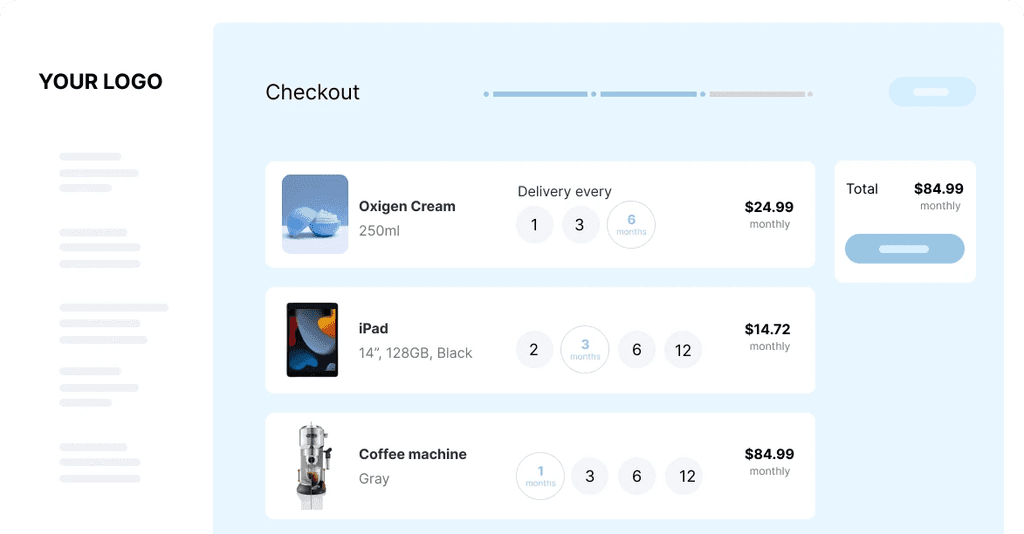Subscription Pricing Strategies: Proven Frameworks for Revenue Growth
Flor Bermúdez

Feb 1, 2025
Understanding the Modern Subscription Economy

Businesses are shifting from selling one-time products to building ongoing customer relationships through subscriptions. The subscription economy creates steady revenue streams while giving customers flexible access to products and services they need. This new model brings fresh opportunities but also requires careful thinking about pricing.
Modern consumers increasingly prefer subscribing over owning. We see this across many industries - from Netflix streaming movies to Adobe selling creative software to companies shipping monthly boxes of clothes. This shift means businesses need smart subscription pricing to succeed.
The numbers tell an impressive story. The subscription market reached $650 billion in 2020 and experts predict it will hit $1.5 trillion by 2025. The average American now spends $273 monthly on subscriptions - everything from phone plans to streaming services. Between 2018-2021, spending on subscriptions grew 15%, with people paying $430 more per year. Check out more data here: Subscription Economy Statistics
Impact on Pricing Strategies
Single-purchase pricing doesn't work for subscriptions. Companies need to balance getting new customers with keeping them long-term. This leads to different approaches like tiered pricing (different service levels), usage-based pricing (pay for what you use), and value-based pricing (price based on customer benefits).
Why Traditional Pricing Falls Short
Old pricing methods miss key parts of the subscription model. Adding a markup to your costs ignores how valuable long-term subscribers are. Copying competitor prices overlooks what makes your service special. Smart subscription pricing considers customer lifetime value, churn rates (how many customers leave), and chances to sell more services over time.
The Psychology of Subscription Adoption
To price subscriptions well, you need to understand what drives customers to subscribe. People like avoiding big one-time payments, getting convenient regular service, and feeling part of an exclusive group. Special features and content can make customers more willing to pay monthly. These factors should shape how you set up pricing tiers and promote your subscriptions.
Building Irresistible Tiered Pricing Models
Smart subscription pricing helps generate reliable recurring revenue. Well-designed pricing tiers attract different customer segments and provide clear value at each level. By studying proven examples, we can create pricing models that work.
The Power of Tiered Pricing
Think of tiered pricing like airplane seating - economy, business, and first class each offer distinct benefits for different budgets. A software company might have a basic tier with core features, a mid-tier plan with extra capabilities, and a premium tier packed with advanced tools. This lets you serve more customers while increasing revenue.
The data shows why this matters: subscription companies have grown 4.6 times faster than S&P 500 businesses in the past 10 years. Major players like Netflix and Amazon Prime use tiered pricing to meet diverse customer needs. See the full growth statistics here.
Defining Your Tiers
The key is making each tier clearly better than the last. Customers should feel the extra cost is worth it for the added features and benefits. The differences between tiers need to be meaningful and easy to understand. Want to see this in action? Check out these 10 Proven Subscription Business Model Examples.
Optimizing Price Points and Upgrade Paths
Setting the right prices requires careful research into:
What competitors charge
Your costs and margins
What customers will pay
Make upgrading attractive by highlighting the extra value in higher tiers. Clear upgrade paths with compelling benefits encourage customers to move up.
Balancing Features and Profitability
Be strategic about which features go in each tier. You want to:
Provide enough value to attract customers
Leave room for upgrades
Avoid cannibalization where basic tiers satisfy everyone
Maintain healthy profits at all levels
Test your pricing with real customers before fully launching. Try A/B testing different models and gather feedback to fine-tune your tiers. This helps validate that your pricing structure works before going all in.
Mastering Data-Driven Price Optimization

Setting the right subscription prices isn't a set-it-and-forget-it task - it requires ongoing analysis and refinement. Smart businesses now rely on concrete data and customer insights rather than gut feelings to make pricing decisions that boost both revenue and customer happiness.
Using Customer Data to Guide Pricing
Top subscription companies analyze real customer behavior to determine optimal price points. They look at what features people actually use, how engaged subscribers are, and direct feedback to package their offerings effectively. This helps them create pricing tiers that truly match what different customer groups want and need.
Testing and Adjusting Prices
Dynamic pricing lets you modify prices based on real-time factors like demand - but it needs a careful touch. Running A/B tests on different pricing models shows you exactly how changes impact sign-ups and cancellations before making them permanent. Through methodical testing, you can find price points that work for both your business and your customers.
Using Data to Predict Price Performance
Advanced analytics help spot pricing opportunities before they become obvious. By examining how different customer groups react to price changes, you can customize your approach for each segment. For instance, some customers might quickly leave after a price increase, while others happily pay more for extra features. Recent research shows how publishers have moved from regular price hikes to smarter, data-driven approaches. Learn more: Explore current subscription pricing trends.
Creating Strong Data Systems for Pricing
Building effective pricing systems means tracking key numbers consistently and being ready to make quick adjustments. The most successful companies balance optimization with customer trust through clear communication. When customers understand exactly what they get at each price point, they're more likely to stick around even as prices evolve. Regular monitoring ensures you capture maximum value while keeping customers happy.
Maximizing Customer Lifetime Value Through Strategic Pricing
Successful subscription pricing does more than attract new customers - it builds lasting relationships that increase customer lifetime value (CLTV). The key is understanding your different customer segments, setting prices that encourage people to stay, and creating clear paths for upgrades.
Identifying and Nurturing High-Value Customers
Some subscribers generate much more revenue than others over time. Finding these valuable customers helps you tailor your pricing and service approach. Look at what they buy, how engaged they are, and their characteristics to spot what makes them special. Then give them extra attention through special perks, custom offers, and proactive support.
Retention-Focused Pricing Models
It costs less to keep current customers than find new ones. Smart pricing helps reduce churn - when customers cancel subscriptions. Consider offering deals on longer commitments, rewards for loyalty, or bonus services that make subscriptions more valuable. This turns pricing from a simple transaction into a way to build customer loyalty.
Creating Compelling Upgrade Paths
Good subscription pricing includes clear ways for customers to upgrade to better plans with real benefits worth the higher cost. This could mean premium features, higher usage limits, or personal support. For example, project software might start with basic tasks, then add team features and advanced reports in premium tiers. Data shows people are willing to pay for value - in Q3 2023, users had 10 different subscriptions on average, spending $381 monthly on optional services. Learn more: Subscription costs and trends in 2023.
Balancing Acquisition Costs and CLTV
Getting new subscribers takes marketing money. Price strategy needs to balance these acquisition costs against expected lifetime value. Lower prices may attract more people, but higher prices can mean more revenue per customer. Using data models to predict CLTV helps set prices for sustainable growth. Read more: Master customer lifetime value.
Predicting and Influencing Customer Behavior
Looking at customer data reveals patterns that help predict future choices. This lets you adjust prices and services proactively. If data shows certain features drive engagement, you might move them to premium tiers. This data-driven approach helps maximize value while building strong customer relationships.
Implementing Strategic Price Changes

Making changes to subscription pricing requires careful planning and execution. A well-designed approach helps maintain strong customer relationships while boosting revenue. The key is focusing on clear communication, smart timing, and showing real value to subscribers.
Communicating Price Updates Effectively
Be upfront and honest about why prices are changing. Let customers know if it's due to rising costs or new features being added. Show them exactly what improvements they'll get - like explaining how a new feature will make their work easier. This helps them see the change as an upgrade rather than just paying more.
Give plenty of advance notice before any price changes. A 30-60 day heads up lets customers plan their budgets and decide if they want to continue. This open approach builds trust and prevents surprises that could upset subscribers. It also gives them time to ask questions and share any worries they might have.
Managing Customer Expectations
Keep the focus on what customers get, not what they pay. Remind them of the benefits they already enjoy and explain how the changes will make things even better. This reinforces that their subscription is worth the investment.
Consider giving customers options. You might add a premium tier with extra features while keeping a basic plan at the current price. This approach, called feature differentiation, puts customers in control by letting them pick what works for their needs and budget.
Grandfathering Existing Customers
Grandfathering means letting current subscribers keep their old price for a set time. While this might mean less money short-term, it shows you value loyal customers and can help keep them around longer. It's a great way to build goodwill and reduce the risk of customers leaving.
Testing Price Elasticity and Timing Changes
Before rolling out big changes, test how customers react to different prices. Try price elasticity tests with small groups to find the sweet spot that brings in more revenue without losing too many subscribers. This careful testing helps avoid costly mistakes.
Think about when to make the change too. Stay away from holidays and busy seasons when customers might be extra sensitive to price increases. Pick a quieter time when the change will be easier for everyone to handle.
Measuring Impact and Responding to Feedback
Watch your numbers closely after the price change. Keep an eye on how many customers leave, how many new ones sign up, and overall revenue. Use this info to see if your strategy is working.
Make it easy for customers to share their thoughts and respond quickly when they do. Show them you're listening and care about making things right. This helps you keep improving your pricing approach while keeping customers happy.
Measuring Success and Optimizing Performance

Good subscription pricing isn't a "set it and forget it" approach - it needs regular review and fine-tuning. The key is turning your business data into clear, actionable insights through careful monitoring. When you track the right metrics, you can catch issues early and find ways to improve your pricing strategy.
Key Metrics for Tracking Pricing Effectiveness
These essential metrics will show you how well your subscription pricing performs:
Customer Acquisition Cost (CAC): The money spent to gain each new subscriber. High CAC often points to pricing problems or marketing that needs work.
Monthly Recurring Revenue (MRR): Your predictable monthly income from subscriptions. Steady MRR growth suggests your pricing works.
Customer Lifetime Value (CLTV): What you expect to earn from each customer during their full subscription time. Higher CLTV means better long-term profits.
Churn Rate: The percentage of subscribers who leave within a specific timeframe. High churn often means pricing issues or unhappy customers.
Average Revenue Per User (ARPU): How much money each subscriber brings in on average. Growing ARPU shows strong pricing strategy.
Building a Solid Monitoring System
A good monitoring setup helps you spot pricing problems quickly and shows where you can do better. Include these key elements:
Simple Dashboards: Easy-to-read visual displays that show your key numbers in real-time help you see patterns and catch problems fast.
Clear Goals: Pick specific targets tied to your pricing aims. For example, if you want higher ARPU, watch that number closely.
Customer Input: Get regular feedback through surveys and conversations. This helps you understand how customers feel about your prices and what needs work. You might be interested in: How to master reducing cart abandonment.
Making Your Pricing Better with Data
Once you're tracking everything, use what you learn to improve your pricing. This ongoing process includes:
Testing Different Options: Try various price points and plans to see what your customers like best.
Looking at Customer Groups: Check how different types of customers respond to your pricing. Some groups might be more price-sensitive than others.
Small, Regular Updates: Make minor pricing tweaks based on what your data shows. These small changes add up to better results over time.
By keeping track of how things are going and adjusting your approach based on real data, you can keep your subscription pricing competitive and profitable.
Want to offer better payment options and boost your sales? Sharpei helps you add rentals, lease-to-own, and subscription choices that can increase sales and make customers happy. Check out our website to learn more.
Related posts
Ready To Join The Circular Movement?
United for a smarter shopping experience and a better planet












